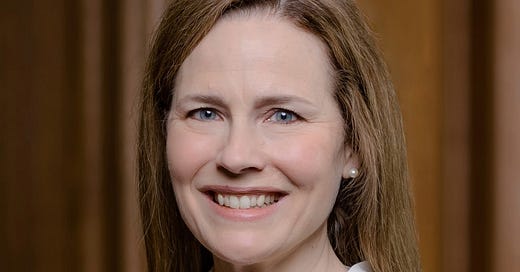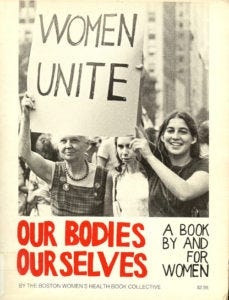Is Amy Coney Barrett a Radical Feminist?
She made it "real" by talking about the female body in explicit detail. Then, she sided with her liberal sisters on the court, dissing the arguments of the anti-abortion contingent.
The estrogen was palpable at the Supreme Court. The air was so thick with it that the men in the room seemed irrelevant.
If you had any doubts that the female sensibility is making a huge mark on the high court, look at what played out during oral arguments in the high-stakes litigation over mifepristone, the abortion pill, on Tuesday.
From the get-go, it was women, women, women. They made the arguments, then took over the rest of the show.
No matter where you stand on the controversy, you have to admit it was kind of awesome to see women playing all the leading roles. On one side of the courtroom was Solicitor General Elizabeth Prelogar, arguing for the government to keep mifepristone available. On the opposite side was Erin Hawley of Alliance Defending Freedom, the Christian advocacy organization that's seeking to cripple access to the medication. (Erin is also the wife of Josh Hawley, the conservative firebrand senator from Missouri.) And arguing for the drug’s manufacturer, Danco Laboratories, was Jessica Ellsworth, a partner at Hogan Lovells.
But the female dominance didn’t stop with the advocates. It was also the women on the high court who drove the discussion. While some of their male colleagues drifted into the land of the obtuse (Justices Samuel Alito and Clarence Thomas mused wistfully about the applicability of the Comstock Act, an antique obscenity law that dates to 1873), the women on the court kept things real.
Blood, fetal tissue, fallopian tubes, and more:
What made it “real” was the way the female justices talked about the female body. Maybe not quite as graphic as the seminal Our Bodies, Ourselves but explicit in its own way. The ladies of the high court went into exacting details about menstruation, leftover fetal tissues, ectopic pregnancies, ultrasounds, and other blood and gore aspects of pregnancy, miscarriage, and abortion. Frankly, it’s hard to imagine any of the male justices getting into that level of discourse about the female anatomy—and maybe that’s just as well.
And no one delved into those details more than Barrett. Not only did the conservative jurist appear to be in alignment with her liberal sisters in this case, she did so with unusual precision and intensity.
Barrett posed detailed, technical questions to the lawyers about women’s bodies after a miscarriage or a D&C (dilation and curettage, a procedure to remove tissue from inside the uterus, that’s associated with abortions).
What’s more, she seemed to know her stuff. Challenging Hawley’s contention that one of her plaintiffs, an OB/GYN, was forced to participate in an abortion, Barrett said: “The fact that she performed a D&C does not necessarily mean that there was a living embryo or fetus. Because you can have a D&C after, you know, a miscarriage.” Later, Barrett added, “you can have complications or excessive bleeding even after the abortion is complete . . . but there’s tissue remaining.”
Was this personal?
“Her questions made me think that this was a subject she knew a lot about and that if she had had a D&C to complete her miscarriage, she didn't want her actions to be judged,” said Miranda McGowan, a constitutional law professor at University of San Diego Law School, noting that NPR had reported that Barrett had experienced miscarriages.
It’s hard not to think that Barrett, a mother of seven children, isn’t speaking from some sort of personal experience. Indeed, she seems to take the issue quite personally—which is precisely why her remarks seem so authentic and powerful.
Dangerously close to the pro-choicers:
What’s also remarkable is that Barrett, who voted to overturn Roe v. Wade, approached the issue as a medical matter, shorn of the typical anti-abortion rhetoric. In a way, she came dangerously close to the pro-choice position that abortion is fundamentally a health issue.
In fact, Barrett helped bolster Solicitor General Prelogar’s position that the plaintiff lacked standing to bring the lawsuit. “Her questions to Prelogar about the conscience exceptions [for doctors who oppose abortion] were so helpfully detailed,” observes McGowan, adding that Barrett helped show “the breadth of the conscience exception,” thus undermining Hawley’s argument that doctors could be forced into completing abortions caused by mifepristone in emergencies. (Hawley produced no evidence that any of her clients ever asked for a conscience waiver.)
I can only guess that conservatives are not thrilled with Barrett’s performance. So is she signaling second thoughts on her vote in Dobbs v. Jackson Women's Health Organization? Maybe a harbinger that she’ll take more of a pro-choice stance on future decisions?
Well, let’s not get that excited. More likely than not, her apparent reluctance to restrict mifepristone at this juncture is that the anti-abortion plaintiffs presented a ridiculously weak case, a view that most of the justices (except Alito and, possibly, Thomas) seem to share.
Still, I’m willing to give Barrett credit for keeping it real—very real. She reminded us why it’s essential to have women’s voices and experiences represented in the highest court in the land.
And how thrilling to see her in unison with her sisters on the court. I know this won’t last but I’m savoring the moment.
Contact: chen.vivia@gmail.com
Twitter (X): ViviaChen







Glad she's aligning with her fellow female justices in her specific questions, but it will take a lot to get over her Roe V. Wade vote. Guess we can hope...
Thanks for sharing this perspective!